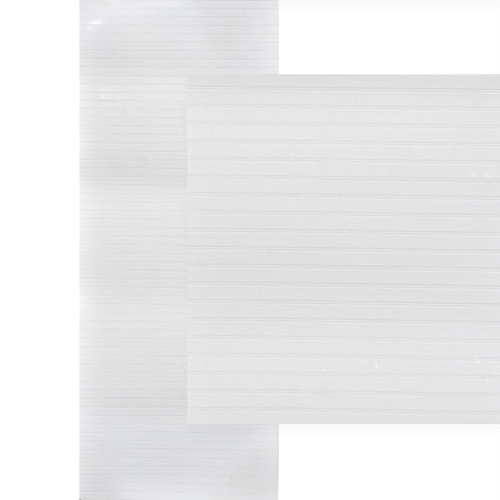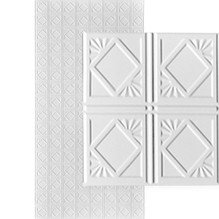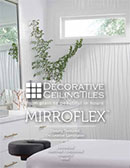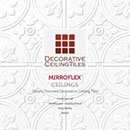
MirroFlex
MirroFlex 3D Vinyl Beadboard Wall Paneling, 4x10
Images are not true representations of the actual color of the product, some are computer generated. Be sure to order samples to make sure the colors will work for you.
How Many Pieces Do I Need?
Project Estimator for
Do you like the look of this product but need help with installation? Learn more in our 'How To' section or get assistance from a professional installer.
- Bulk Pricing:
- Buy in bulk and save
- Model No.
- 124-5001-BEAD
- Condition:
- New
- Availability:
- Pre-Order
- Delivery:
- 3 weeks lead time
- Size:
- 48" x 120"
- Weight:
- 8lb (per panel)
- Material:
- PVC
- Coverage:
- 40 sqft
- Material Thickness:
- 0.030"
- Fire Rating:
- Class"A" Passing test ASTM E84 (painting voids fire rating)
- Installation Method:
- Glue Up
- Adhesive:
- Spray Lock FRP
- Adhesive Note:
- 1 tube covers 2 panels
- Colors Options:
- View colors and finishes or use our MirroFlex visualizer tool
- Special Note:
- (Mirror Silver, Mirror Gold, Brushed Aluminum, and Brushed Copper) do not form as deep as the other finishes.
- Return Policy:
- This product is made to order in USA and returns are not allowed. Consider ordering samples first to check quality and finish.
- Shipping Label:
- 4x8 Wall Panel Non-Rollable
About Our MirroFlex Vinyl Beadboard Ceiling and Wall Panels
If you want to upgrade the style of your home but don't want to break the bank to do so, you should consider vinyl beadboard panels from Decorative Ceiling Tiles. Beadboard for walls was a popular design trend during the Victorian era, but even today, beadboard is still found in many homes and businesses because of its simple and attractive aesthetic. Vinyl beadboard panels are similar to more traditional paneling because of the distinctive groove pattern, but they're more affordable and easier to install. Order your wall or ceiling beadboard panels from us today to get a high-quality product at an affordable price!
What Is Vinyl Beadboard, and What Are Its Benefits?
Vinyl beadboard paneling gives you the look of beadboard in a more modern material. If you think about it, a lot of your home probably already uses vinyl in some form. Do you have vinyl windows or siding? Maybe you have vinyl porch posts, a vented soffit, or a vinyl railing. Vinyl is used in lots of places around the home, and it can mimic many different materials, so you might not even notice that it's there.
Vinyl PVC beadboard can provide you with a more professional finish without painting. A PVC beadboard ceiling or wall panel can also provide a durable finish that is resistant to scratches and dents. It's water-resistant and rot-free, and it requires little to no maintenance to keep it looking its best. Vinyl beadboard ceiling or wall paneling also adds a bit of insulation to your home and protects surfaces from chair bumps and other damage.
Can You Paint Vinyl Beadboard?
Yes! Most vinyl beadboard comes in a white or cappuccino color, but you can paint vinyl beadboard panels any color you wish. Be sure to start with a good-quality acrylic primer to help the vinyl surface accept the paint better. Use an angled trim brush to apply the primer to the wall edges, and then apply the primer to the broader areas using a roller. If you have existing vinyl beadboard panels installed but want to boost your curb appeal, painting your wall panels can be a lot less expensive than replacing them.
How to Use Vinyl Beadboard Around the Home
- Vinyl beadboard panels are typically installed vertically on walls, creating the look of traditional striped paneling, but some people have begun to install vinyl beadboards horizontally for a unique look. Many people use PVC beadboard panels for walls in their dining and laundry rooms.
- Cover up old plaster that has unsightly cracks and blemishes with vinyl beadboard panels. You can also use these wall panels to cover up popcorn ceilings and create a more appealing visual texture that pulls the eye upward.
- Vinyl beadboard panels or solid soffit material can be used to create a finished vinyl beadboard ceiling on your porch.
- Using vinyl beadboard to create a chair rail adds a polished look to a space that can help to tie everything together.
Installing Vinyl Beadboard Walls
You don't need to be an expert to install vinyl beadboard panels on your own. In fact, it can prove to be a fun DIY project. All you need are some basic tools and know-how.
Beadboard wall paneling can easily be installed over your existing drywall with a good panel adhesive like Liquid Nails. While the adhesive cures, you can also use brads or nails to temporarily hold the panels in place.
If you install vinyl beadboard in your kitchen or bathroom, make sure the paneling and molding adhesive you use is water-resistant. You should also nail each panel through the lap joint within the top half an inch. This way, the nail you use will be covered by the top cap molding on the wall.
If you're feeling a little unsure about installing your new MirroFlex vinyl beadboard paneling yourself, watch our video tutorial to see how it's done!
The Cost of Vinyl Beadboard
Vinyl beadboard paneling is a much more affordable alternative to real wood beadboard and comes in many colors. Full vinyl beadboard panels cost less than $200, which breaks down to less than $5 per square foot; wood paneling can cost more than twice that amount, and you'll often still need to stain or paint it.
In either case, you should also consider the installation cost of beadboard walls. With our vinyl beadboard ceiling and wall panels, it's simple to do the installation yourself, adding to the cost savings. But if you choose wooden paneling, you can expect to pay at least $4 per square foot for a professional to install it.
It's easy to see why vinyl beadboard panels are a smart choice for your home: Not only are they an attractive and practical addition to any space, but they're affordable, too. Order yours from Decorative Ceiling Tiles today!
Technical Data
MirroFlex EccoFlex Technical Data Sheet MirroFlex Technical Info MirroFlex Structures Technical Info Spec SheetTest Data
NRC Test Data ASTM C423 - Full-Size Reverberation Room NRC Test Data SAE J2883-Small Reverberation RoomCompatibility Study
DIVERSEY Healthcare Cleaning ProductsProposition 65
Proposition 65 Compliance LetterAbout Our MirroFlex Vinyl Beadboard Ceiling and Wall Panels
If you want to upgrade the style of your home but don't want to break the bank to do so, you should consider vinyl beadboard panels from Decorative Ceiling Tiles. Beadboard for walls was a popular design trend during the Victorian era, but even today, beadboard is still found in many homes and businesses because of its simple and attractive aesthetic. Vinyl beadboard panels are similar to more traditional paneling because of the distinctive groove pattern, but they're more affordable and easier to install. Order your wall or ceiling beadboard panels from us today to get a high-quality product at an affordable price!
What Is Vinyl Beadboard, and What Are Its Benefits?
Vinyl beadboard paneling gives you the look of beadboard in a more modern material. If you think about it, a lot of your home probably already uses vinyl in some form. Do you have vinyl windows or siding? Maybe you have vinyl porch posts, a vented soffit, or a vinyl railing. Vinyl is used in lots of places around the home, and it can mimic many different materials, so you might not even notice that it's there.
Vinyl PVC beadboard can provide you with a more professional finish without painting. A PVC beadboard ceiling or wall panel can also provide a durable finish that is resistant to scratches and dents. It's water-resistant and rot-free, and it requires little to no maintenance to keep it looking its best. Vinyl beadboard ceiling or wall paneling also adds a bit of insulation to your home and protects surfaces from chair bumps and other damage.
Can You Paint Vinyl Beadboard?
Yes! Most vinyl beadboard comes in a white or cappuccino color, but you can paint vinyl beadboard panels any color you wish. Be sure to start with a good-quality acrylic primer to help the vinyl surface accept the paint better. Use an angled trim brush to apply the primer to the wall edges, and then apply the primer to the broader areas using a roller. If you have existing vinyl beadboard panels installed but want to boost your curb appeal, painting your wall panels can be a lot less expensive than replacing them.
How to Use Vinyl Beadboard Around the Home
- Vinyl beadboard panels are typically installed vertically on walls, creating the look of traditional striped paneling, but some people have begun to install vinyl beadboards horizontally for a unique look. Many people use PVC beadboard panels for walls in their dining and laundry rooms.
- Cover up old plaster that has unsightly cracks and blemishes with vinyl beadboard panels. You can also use these wall panels to cover up popcorn ceilings and create a more appealing visual texture that pulls the eye upward.
- Vinyl beadboard panels or solid soffit material can be used to create a finished vinyl beadboard ceiling on your porch.
- Using vinyl beadboard to create a chair rail adds a polished look to a space that can help to tie everything together.
Installing Vinyl Beadboard Walls
You don't need to be an expert to install vinyl beadboard panels on your own. In fact, it can prove to be a fun DIY project. All you need are some basic tools and know-how.
Beadboard wall paneling can easily be installed over your existing drywall with a good panel adhesive like Liquid Nails. While the adhesive cures, you can also use brads or nails to temporarily hold the panels in place.
If you install vinyl beadboard in your kitchen or bathroom, make sure the paneling and molding adhesive you use is water-resistant. You should also nail each panel through the lap joint within the top half an inch. This way, the nail you use will be covered by the top cap molding on the wall.
If you're feeling a little unsure about installing your new MirroFlex vinyl beadboard paneling yourself, watch our video tutorial to see how it's done!
The Cost of Vinyl Beadboard
Vinyl beadboard paneling is a much more affordable alternative to real wood beadboard and comes in many colors. Full vinyl beadboard panels cost less than $200, which breaks down to less than $5 per square foot; wood paneling can cost more than twice that amount, and you'll often still need to stain or paint it.
In either case, you should also consider the installation cost of beadboard walls. With our vinyl beadboard ceiling and wall panels, it's simple to do the installation yourself, adding to the cost savings. But if you choose wooden paneling, you can expect to pay at least $4 per square foot for a professional to install it.
It's easy to see why vinyl beadboard panels are a smart choice for your home: Not only are they an attractive and practical addition to any space, but they're affordable, too. Order yours from Decorative Ceiling Tiles today!






















































